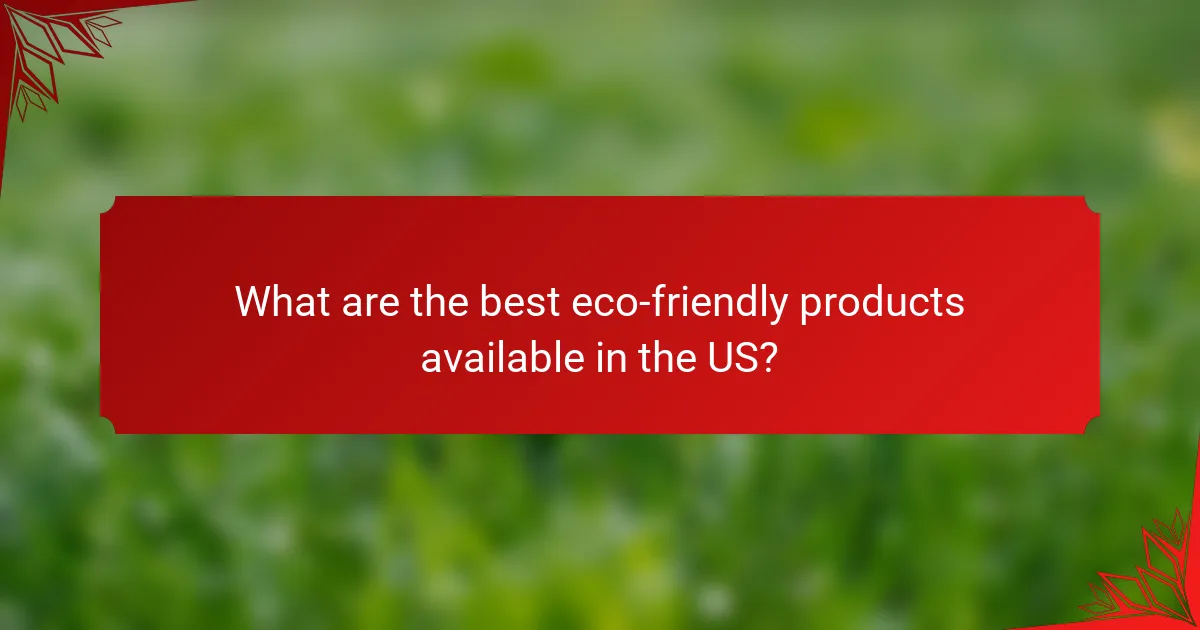Eco-friendly products are designed to reduce environmental impact while offering practical benefits, making them essential for eco-conscious consumers. By focusing on sustainability, biodegradability, and reusability, these products not only help conserve resources but also promote sustainable practices throughout their lifecycle. When selecting such items, it’s important to consider their material sustainability and certifications to ensure they effectively minimize waste and contribute positively to the environment.

What are the best eco-friendly products available in the US?
The best eco-friendly products in the US include items designed to reduce environmental impact while providing practical benefits. Popular choices focus on sustainability, biodegradability, and reusability, making them ideal for eco-conscious consumers.
Bamboo toothbrushes
Bamboo toothbrushes are a sustainable alternative to traditional plastic toothbrushes. Made from renewable bamboo, they are biodegradable and can decompose within a few months after disposal.
When choosing a bamboo toothbrush, look for options with soft bristles made from plant-based materials. This ensures a gentle cleaning experience while minimizing plastic waste.
Reusable silicone bags
Reusable silicone bags are versatile storage solutions that replace single-use plastic bags. They are durable, dishwasher-safe, and can be used for food storage, travel, or organizing household items.
Consider investing in a set of varying sizes to accommodate different needs, from snacks to larger meal prep items. These bags can last for years, significantly reducing plastic waste over time.
Compostable dishware
Compostable dishware is made from natural materials like sugarcane, bamboo, or palm leaves, providing an eco-friendly alternative to plastic plates and utensils. They break down in composting facilities, returning nutrients to the soil.
When using compostable dishware, ensure they are disposed of in a composting environment to achieve their full environmental benefits. Look for certifications like ASTM D6400 to confirm compostability.
Biodegradable cleaning supplies
Biodegradable cleaning supplies include products formulated to break down naturally without harming the environment. These often use plant-based ingredients and are free from harsh chemicals.
Check for labels indicating biodegradability and look for refillable options to reduce packaging waste. Brands that prioritize eco-friendly practices often offer effective cleaning solutions without compromising safety.
Organic cotton tote bags
Organic cotton tote bags are a sustainable alternative to plastic shopping bags. Made from cotton grown without synthetic pesticides or fertilizers, they are reusable and biodegradable.
When selecting a tote bag, choose one that is durable and machine washable. This ensures longevity and cleanliness, making it a practical choice for everyday use while minimizing plastic consumption.

How do eco-friendly products benefit the environment?
Eco-friendly products benefit the environment by reducing pollution, conserving resources, and promoting sustainable practices. These products are designed to minimize their ecological impact throughout their lifecycle, from production to disposal.
Reduce plastic waste
Using eco-friendly products significantly reduces plastic waste, which is a major environmental concern. Many of these products are made from biodegradable materials or are designed to be reusable, helping to decrease the amount of plastic that ends up in landfills and oceans.
For example, opting for reusable shopping bags instead of single-use plastic bags can cut down on plastic consumption. Simple actions like this can lead to a noticeable reduction in plastic waste over time.
Lower carbon footprint
Eco-friendly products typically have a lower carbon footprint compared to their conventional counterparts. This is achieved through sustainable manufacturing processes, reduced energy consumption, and the use of renewable resources.
For instance, products made from organic materials often require less energy to produce and generate fewer greenhouse gas emissions. Choosing local products can further minimize transportation emissions, contributing to a smaller overall carbon footprint.
Conserve natural resources
Eco-friendly products help conserve natural resources by utilizing sustainable materials and reducing the demand for non-renewable resources. This approach encourages the responsible use of resources like water, timber, and minerals.
For example, products made from recycled materials lessen the need for virgin resources, thereby preserving ecosystems and reducing habitat destruction. Supporting brands that prioritize sustainable sourcing can amplify these conservation efforts.
Promote sustainable practices
By choosing eco-friendly products, consumers promote sustainable practices that can influence industries and communities. This creates a demand for environmentally responsible production methods and encourages companies to adopt greener practices.
Participating in initiatives like zero-waste movements or supporting businesses that prioritize sustainability can foster a culture of environmental responsibility. Educating others about the benefits of eco-friendly choices can further amplify this positive impact.

What criteria should you consider when selecting eco-friendly products?
When selecting eco-friendly products, consider their material sustainability, certifications, and overall product lifecycle. These criteria help ensure that your choices contribute positively to the environment and minimize waste.
Material sustainability
Material sustainability refers to the environmental impact of the materials used in a product. Look for items made from renewable resources, recycled materials, or biodegradable substances. For example, bamboo and organic cotton are often more sustainable than conventional cotton or plastic.
Evaluate the sourcing practices of manufacturers. Products that use local materials can reduce transportation emissions, while those that are certified organic or sustainably harvested often have a lower environmental footprint.
Certifications and labels
Certifications and labels provide assurance that a product meets specific environmental standards. Look for recognized certifications such as Energy Star, USDA Organic, or Fair Trade, which indicate adherence to sustainability practices.
Be cautious of greenwashing, where products falsely claim to be eco-friendly. Research the meaning behind labels and choose products with transparent certification processes to ensure genuine sustainability.
Product lifecycle
The product lifecycle encompasses all stages from production to disposal. Assess how long a product will last, its potential for reuse, and how it can be recycled at the end of its life. Durable products that can be repaired or repurposed are often more sustainable.
Consider the environmental impact at each stage, including manufacturing, transportation, usage, and disposal. Products designed for easy recycling or composting can significantly reduce waste and promote a circular economy.

How can you minimize waste with eco-friendly products?
Minimizing waste with eco-friendly products involves choosing items designed to reduce environmental impact and adopting practices that limit waste generation. By integrating sustainable habits into daily life, individuals can significantly decrease their overall waste footprint.
Adopting a zero-waste lifestyle
A zero-waste lifestyle focuses on reducing waste to the maximum extent possible, aiming to send nothing to landfills. This can be achieved by prioritizing reusable items, composting organic materials, and recycling whenever possible.
Start by evaluating your consumption habits and identifying areas where waste can be reduced. Simple changes, such as carrying reusable bags and containers, can lead to significant reductions in single-use plastics.
Using refillable containers
Refillable containers are an effective way to minimize waste by reducing the need for single-use packaging. Many stores now offer bulk sections where consumers can fill their own containers with products like grains, liquids, and personal care items.
To make the most of refillable containers, keep a set handy for grocery shopping and personal care products. This not only cuts down on waste but can also save money in the long run, as bulk items are often cheaper than their packaged counterparts.
Composting organic waste
Composting organic waste transforms food scraps and yard waste into nutrient-rich soil, significantly reducing landfill contributions. This process can be done at home with a compost bin or through municipal composting programs.
To start composting, collect kitchen scraps like vegetable peels, coffee grounds, and eggshells, along with yard waste such as leaves and grass clippings. Aim for a balanced mix of green (nitrogen-rich) and brown (carbon-rich) materials to create an effective compost pile.

What are the cost implications of eco-friendly products?
Eco-friendly products often come with higher upfront costs but can lead to significant savings over time. Understanding the financial implications involves evaluating both initial investments and potential long-term benefits.
Initial investment vs. long-term savings
When purchasing eco-friendly products, consumers typically face a higher initial investment compared to conventional alternatives. For instance, energy-efficient appliances may cost 10-30% more upfront, but they can reduce utility bills significantly over their lifespan.
Long-term savings can be substantial. For example, LED light bulbs, while more expensive initially, consume up to 80% less energy than traditional bulbs, resulting in lower electricity costs. Over several years, these savings can offset the higher purchase price.
To maximize benefits, consider the total cost of ownership, which includes maintenance, energy consumption, and durability. Researching product lifespans and energy ratings can help in making informed decisions that balance initial costs with future savings.



